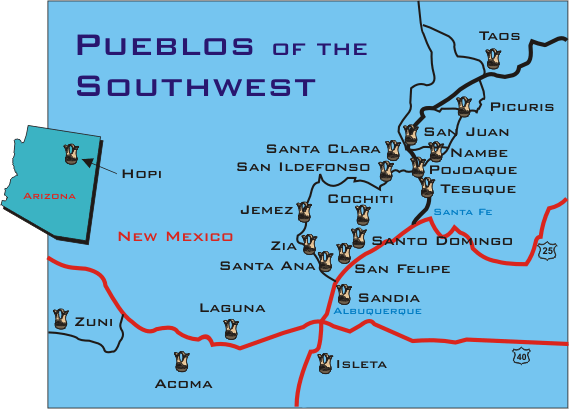 ClayHound Web
- Picuris Pueblo
ClayHound Web
- Picuris PuebloReturn to:
|
Picuris Pueblo Pottery |
|
|
|
|
|
|
|
|
Picuris Pueblo is located in north-central New Mexico. Picuris and Taos have followed pottery traditions quite different from those of the other pueblos. Their utilitarian wares more closely resemble the nearby Apache pottery in being unpainted, unpolished, and decorated, if at all, only with such sculptural features as knobs, ribbons, or punching. The unpolished surfaces of the vessels were often intentionally roughened with combings or other striations, especially in the eighteenth and nineteenth centuries. Some were constructed by pressing the clay into baskets, thus producing a characteristic surface that looks as though a corncob had been rolled over it. For perhaps a century little pottery has been manufactured at Taos Pueblos, while Picuris Pueblo has been a ceramic leader and even today produces small quantities of serviceable pottery. The Tewa Indians sometimes copied the style of Picuris and Taos but used a different clay and temper. At Taos and Picuris the clay is formed of decayed pre-Cambrian schist, filled with abundant flecks of mica throughout, while the Tewa achieved the same metallic luster by coating their clay with a thick, glittery finish. The surrounding villages of Spanish-Americans have often used and appreciated the utilitarian pottery from Picuris and Taos. Picuris pots are characterized by their mottled appearance, which varies from glittery orange metallic to almost black, while Taos pots are often more uniform in color. |
|
|
Named "Pikas" - those who paint - by Spanish explorer Don Juan de Oņate, the Pueblo of Picuris is located 24 miles (38 kilometers) southeast of Taos in the Sangre de Cristo Mountains. Picuris tribal members number just over 330. It has taken tribal members eight years to restore, by hand, the 200-year-old adobe church, San Lorenzo de Picuris, which graces the center of the Pueblo. |
|
|
from - http://www.newmexico.org/culture/pueblo_picuris.html |
|



